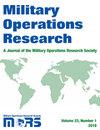Rethinking the Hierarchy of Analytic Models and Simulations for Conflicts
IF 0.3
4区 管理学
Q4 OPERATIONS RESEARCH & MANAGEMENT SCIENCE
引用次数: 12
Abstract
F or decades, analysts within the defense community have categorized their analytic models and simulations for decision support through a hierarchy expressed in terms of resolution. The hierarchy is usually depicted as a pyramid that has levels of ‘‘engineering and physics,’’ ‘‘engagement,’’ and ‘‘mission,’’ to the most aggregate level of ‘‘campaign’’ models. In this article, we accomplish three enhancements. First, we document the importance of applying a hierarchy of models and simulations, which some have questioned because of increased computer speed. Second, we list factors to consider in describing a model or simulation’s resolution, which we hope aids interfacing model results and calibrating across levels. Third, we propose expanding the hierarchy to include two more levels beyond campaign to include levels of ‘‘defense enterprise’’ and ‘‘government, nongovernment, and coalition instruments of power.’’ We use these levels to categorize models constructed to aid decisions requiring evaluations beyond a single campaign’s results. The growing emphasis on disparate coalition operations along with the increasing interplay of broader government and nongovernmental capabilities points to a need to extend this traditional hierarchy. We propose refining the hierarchy to depict both model and simulation breadth (scope) and depth (resolution) along with our recommended two additional levels of abstraction.对冲突分析模型和仿真的层次再思考
几十年来,防务界的分析人员已经将他们的分析模型和模拟进行了分类,以便通过以分辨率表示的层次结构来支持决策。这个层次结构通常被描绘成一个金字塔,它有“工程和物理”、“参与”和“任务”等层次,直到“活动”模型的最综合层次。在本文中,我们完成了三个增强。首先,我们记录了应用模型和模拟的层次结构的重要性,由于计算机速度的提高,一些人对此提出了质疑。其次,我们列出了描述模型或模拟分辨率时要考虑的因素,我们希望这些因素有助于连接模型结果和跨级别校准。第三,我们建议扩大等级制度,在运动之外再包括两个层次,包括“国防企业”和“政府、非政府和联盟的权力工具”。“我们使用这些级别对模型进行分类,以帮助需要评估的决策而不是单一活动的结果。越来越多地强调不同的联合行动,以及更广泛的政府和非政府能力的日益相互作用,表明需要扩展这种传统的等级制度。我们建议细化层次结构,以描述模型和模拟的广度(范围)和深度(分辨率),以及我们推荐的两个额外的抽象级别。
本文章由计算机程序翻译,如有差异,请以英文原文为准。
求助全文
约1分钟内获得全文
求助全文
来源期刊

Military Operations Research
Engineering-Mechanical Engineering
CiteScore
0.40
自引率
0.00%
发文量
0
期刊介绍:
Military Operations Research is a peer-reviewed journal of high academic quality. The Journal publishes articles that describe operations research (OR) methodologies and theories used in key military and national security applications. Of particular interest are papers that present: Case studies showing innovative OR applications Apply OR to major policy issues Introduce interesting new problems areas Highlight education issues Document the history of military and national security OR.
 求助内容:
求助内容: 应助结果提醒方式:
应助结果提醒方式:


